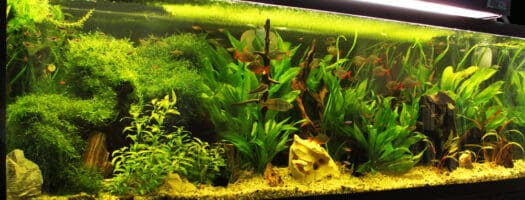The 10 Best Filters for Turtle Tanks in 2026
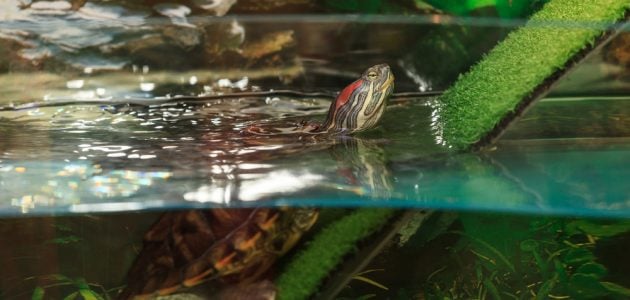
Owning a turtle is like having your very own mini-dinosaur as a pet. While that’s every bit as cool as it sounds, it does take a lot of work.
Not for the turtle, of course. For your aquatic friend, life’s a joy. If they’re not swimming, they’re soaking in the UV rays from atop their basking rock, or chomping down on fresh cucumber slices. But as an owner, things aren’t so simple. Turtles are extremely messy and their tanks become dirty and smelly at an alarming rate.
In fact, first-time owners routinely underestimate the extra maintenance that’s required when compared to fish-keeping, and even experienced turtle keepers get frustrated with the frequency of cleaning. Thankfully there’s a simple fix: a high-quality turtle tank filter. Buying an effective and appropriate filter will clear dirty, sludgy water and change a greenish swamp to a crystal-clear reptile haven in a matter of hours. Here’s everything you need to know.
- How to Choose a Filter for Your Turtle Tank
- Top 10 Best Filters for Turtle Tanks 2026
- 1. Best Overall Filter for Turtle Tanks: Fluval 07 Series
- 2. Best Premium Filter for Turtle Tanks: Fluval FX6 Canister
- 3. Best Decorative Filter: Tetra Decorative ReptoFilter
- 4. Most Valve Flexibility: Penn-Plax Cascade Canister
- 5. Best Pond Filter: Pond Boss Filter Kit
- 6. Best Algae-Clearing Internal Filter: Coospider Sun JUP-01
- 7. Best Hang-On Filter: Aqua Clear
- 8. Best Budget Filter for Turtle Tanks: Tetra Internal Power Filter With Whisper Filtration
- 9. Best No-Noise Filter: Penn-Plaxx Cascade 600 Submersible
- 10. Best UV Sterilizing Canister Filter: SunSun HW 304B
- Guide to Buying the Best Filters for Turtle Tanks
- Filtering the Good From the Bad
How to Choose a Filter for Your Turtle Tank
Many of the best turtle tank filters weren’t specifically designed for use with turtles. Some aren’t marketed towards turtle owners at all, which can make it tricky to determine a filter’s suitability for your hard-shelled friend. So before we go any further, here’s an overview of the different aquarium filter types.
The 4 Types of Filters for Turtle Tanks
- Canister filters: They sit outside the tank with water passing via intake and output tubes
- Internal filters: These are smaller and sit inside the tank, beneath the waterline
- Hang-on filters: As the name suggests, they hang from the top of the tank
- Undergravel filters: Filters like this sit underneath the tank’s substrate
For a full breakdown on the advantages and disadvantages of these different filter types, head over to our canister vs. internal vs. hang-on section. In any case, we’ve included the best of each in our review list.
Filter type isn’t the only consideration you need to make, but fear not, we’ve done the heavy lifting for you here and developed a handy list of factors to help inform your buying decision.
Size
You need a filter capable of handling the volume of water that your turtle is housed in. Get this wrong and soon enough you’ll be back shopping for a filter.
Most capacity recommendations are given with fish in mind. Turtles are much messier, so when a filter isn’t specifically indicated for turtle use, we advise that you choose a filter that’s designed to handle double the size of your tank.
If you need help with this, head over to our in-depth sizing section, where we give specific filter recommendations for different tank sizes.
Flow Rate (GPH)
Gallons Per Hour (GPH) is a metric for the volume of water that the filter is capable of processing each hour. At a bare minimum, you should choose a filter that can filter the entire volume of your tank within this timeframe.
Importantly, manufacturers measure GPH inside testing facilities and use tanks without decor or turtles inside. As a result, the advertised performance isn’t always replicated with regular home use. Where they differ, our reviews note the actual flow rate you can expect, rather than what’s written on the box.
Filtration Method
Tank filters use one or more methods of filtration (biological, mechanical, and chemical) with the water passing through multiple compartments. This is pretty important stuff and we have a whole section dedicated to filtration mechanisms later in this guide.
In short, mechanical and biological filtration is essential, and chemical is a bonus. Every filter in our review list uses at least mechanical and biological filtration.
Maintenance
Filter media inevitably needs replacing from time to time, and when it does, the right filter will make this much easier. The best designs keep filter media independently housed, where it can be easily removed from the main unit. Plus, the more space for filter media, the better the filtration will be – you’ll have a more stable nitrogen cycle, and the filter will require less cleaning.
Durability
Turtle filters are tasked with a heavy workload and need to run continuously. As such, their durability should be a key factor in your buying decision. Impeller motors are the most common point of failure, but you should also consider the plastic casing and valve quality, too. Generally speaking, canister filters are more durable, but often come with a much higher price tag.
Noise
As many turtle parents keep their beloved aquatic pets close to where they sleep, don’t neglect the noise factor during your considerations. This is most impacted by how the water breaks the surface. Canister filters are often the quietest as the tubing sits beneath the waterline, whereas hang-on-filters are the loudest as the water splashes down from above.
Still not sure where to start? You’re in luck – we’ve used the above factors as criteria to review all of the premier turtle tank filters available today. Let’s get right to it.
Top 10 Best Filters for Turtle Tanks 2026
1. Best Overall Filter for Turtle Tanks: Fluval 07 Series

Editor’s Rating:
Why we like it: For years Fluval’s ‘06 series’ dominated the market as the go-to choice for premier canister filtration. Fluval’s newer ‘07 series’ is better in every way and a shoo-in for our best overall filter.
Quick Facts:
- Models available: 107, 207, 307, 407
- Filter type: Canister
- Filter mechanism: Mechanical, biological, and chemical + ‘pre-filter’
- Suitable for tank sizes: 10-100 gallons (depending on model)
- Flow rate (GPH): 145-383 (depending on model)
Size
The 07 Series is made up from 4 high-performance canister models, with varying flow rates to accommodate tanks from 10 to 100 gallons. For the vast majority of turtle-owners, one of these four sizes will be just the ticket, and it’s the best overall performing filter we’ve seen at every size. Just remember to buy a size suitable for double your tank’s capacity, as these filters aren’t designed specifically with turtles in mind.
Filtration
The 07 Series goes above and beyond, boasting comprehensive chemical filtration, with 3 specialist pads to target phosphate, ammonia, and nitrite. Together, these pads work to stabilize your tank’s nitrogen cycle, and will prevent your turtle from being damaged by nasties that are invisible to the eye!
Plus, it’s the only filter reviewed that includes a ‘pre-filter’ stage. This pre-filter is a thick sheet of rippled porous ‘bio-foam’ that captures waste and debris before water passes through to the main filtration system. The benefit here is that your primary filter media has less work to do, so it’ll last longer and clog less frequently. As unclogging media is perhaps an aquarist’s most dreaded maintenance task – this benefit really can’t be overstated.
Maintenance
The 07 Series truly makes maintenance simple. Each model includes an ‘EZ-lift media basket’ that allows every media compartment to be removed simultaneously, in one movement. You can’t get this wrong, and it’s more time-efficient than tackling each media compartment independently, as is commonplace with other canisters. Plus, you don’t need to empty the water canister before changing the media, which means less chance of splashes and spills.
Durability
It’s constructed from robust, fiber-reinforced plastic, and the clamps and valves are ribbed and ergonomically-shaped. We love this design and find it really helps prevent your hands from slipping when they inevitably get wet during water changes. Spilling dirty canister water will ruin your week, so this gets top marks on our scorecards.
This robust and durable design does come at a cost though, and 07 Series models occupy the top end of the price range at each size. For a canister filter with a similar performance that’s a little easier on the wallet, check out the Penn-Plax Cascade Canister.
Noise
Canister filters do tend to vibrate and it’s not uncommon to hear a constant rattling sound. This is rarely mentioned in product reviews and often overlooked by buyers. Thankfully, this is a non-issue with the 07 series – it comes with rubber feet stabilizers that offer a solid support base and absorb any vibrational sound. Only the Fluval FX6 is quieter.
Pros
- ‘Pre-filter’ stage for elite filtration performance
- Unique ‘EZ lift’ basket design
- Constructed from durable, reinforced plastic
- Ergonomically designed
- Ultra-quiet operation
Cons
- High price point
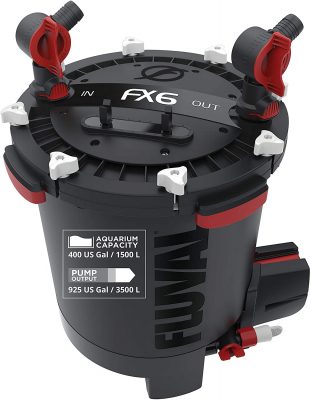
Editor’s Rating:
Why we like it: Simply put, the Fluval FX6 offers the most powerful and effective filtration on the market. It’s the Lamborghini of turtle tank filters - expensive, but worth every penny.
Quick Facts:
- Filter type: Canister
- Filter mechanism: Mechanical, biological, and chemical
- Suitable for tank sizes: Up to 400 gallons
- Flow rate (GPH): 925
Size
This filter is suitable for filtration in tanks up to a staggering 400 gallons. Only the Pond Boss can beat this (up to 500 gallons), and that filter is intended for ponds, not tanks. As you may expect, the canister itself is large – with a height of almost 21” – so make sure you have sufficient room to house it before you part with your hard-earned dollars.
Filtration
In terms of filtration performance, the Fluval FX6 is the best of the bunch and it’s not particularly close. In fact, it’s too powerful for tanks on the smaller end. It’s made specifically for large setups (think multiple turtles or larger species), and this is the only reason it didn’t pinch our top spot. Ultimately, it’s just not as beginner-friendly or versatile as the Fluval 07 Series.
Circular media baskets allow for a whopping six stacks of filter media (hence the name FX6), which will keep your tank water clean and clear, even if pooping is your aquatic friends’ favorite pastime. Plus, this filter has so much space for filter media, when fully packed it’s possible to go as long as months between cleans. This is practically unheard of for turtle-keeping and makes it the most convenient option for those who value their time above all else.
Maintenance
An in-built utility valve allows for simple canister draining and refilling, resulting in seamless, no-spill water changes. Plus, the FX6 uses ‘smart pump technology.’ This means the pump automatically pauses for a brief period every 12 hours, allowing any trapped air to escape. The result is consistently maximal filtration efficiency without any manual intervention being required. No other filter includes this feature.
Durability
No shortcuts were taken in construction here and with proper care, you can expect it to last for decades. When you couple this with its outstanding filtration capability, the FX6 is the perfect choice for those looking to make a long-term investment and expecting to add more turtles, or switch to a larger tank, in the future.
Noise
The FX6 uses ‘low-wear, frictionless rotors’ and ‘noise-dampening materials’ inside the canister. While these might sound nonsense buzzwords, it’s not just hype. This filter is surprisingly quiet – it makes less noise than every Fluval 07 Series model – despite being significantly more powerful.
Pros
- Unmatched filtration capacity and flow rate
- Impressive space for filter media
- Spill-free water changes
- Uses ‘smart pump technology
- Quiet operation
Cons
- Overkill for small/medium tanks
- Large canister
3. Best Decorative Filter: Tetra Decorative ReptoFilter
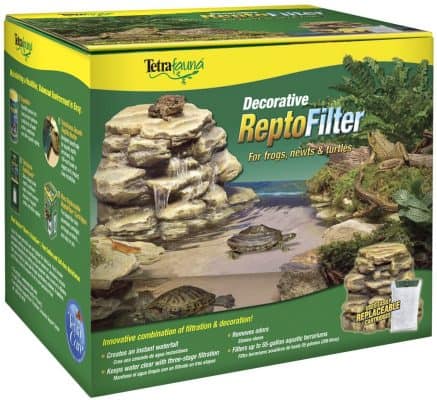
Editor’s Rating:
Why we like it: Double trouble! This internal filter is built into a natural-looking rock formation and water feature that’ll instantly improve your turtle’s habitat.
Quick Facts:
- Filter type: Internal
- Filter mechanism: Mechanical, biological, and chemical
- Suitable for tank sizes: Up to 55 gallons
- Flow rate (GPH): 90
Size
Both the decorative waterfall feature and rock formation help to create a realistic-looking habitat (and basking spot) for your hard-shelled friend, and the extra tank space it needs is outweighed by the improved aesthetic. Unfortunately, we find the listed GPH is unattainable in practice. Still, as it’s specifically made for reptiles, this should do the job for tanks within the product’s recommendations – up to 55 gallons.
Filtration
Like the Tetra Internal Power Filter, the ReptoFilter uses replaceable ‘bio-bags’ for its three-stage filtration, which do a great job of containing the awful stench that turtle waste has a reputation for. You’ll need to buy replacement bio-bags occasionally, but this won’t hurt your pockets enough to be a deal-breaker.
Plus, the filter sits at the bottom of the tank, making it suitable for use in shallow water, and you won’t have to raise the waterline to accommodate its use. High waterlines are usually one of the biggest drawbacks of using an internal filter, and this ReptoFilter design sidesteps the problem entirely.
Maintenance
Maintenance is simple, and helpful ‘min/max’ levels are marked on the structure so you needn’t worry about under/over-filling during water changes. Plus, the bio-bags make cleaning less messy than handling traditional filter media trays. Unfortunately, we find this filter is still prone to clogging and the rock exterior quickly picks up algae and other dirt – adding time to your weekly cleaning routine.
Durability
The ReptoFilter uses a clever locking feature to keep turtles away from the internal mechanisms. This isn’t something to be skipped over – curious turtles often end up getting themselves stuck inside the filtering mechanism or gnawing away at its parts. Of course, the latter can turn a good filter into a hunk of junk in a matter of moments. Overall, this is the most durable internal filter we reviewed.
Noise
The ReptoFilter sits in the middle of the pack in terms of its noise production. For comparison, it’s much quieter than the Penn-Plax Cascade Canister, but it’s markedly louder than top-end canister filters like the Fluval 07 Series.
SIMILAR VARIATIONS: If you like the look of the ReptoFilter but have a larger tank that would suit a more elaborate rock formation, consider the Vivaquarium. Alternatively, if you’d prefer to construct your very own rock formation filter – consider this ReptoFilter variation.
Pros
- Improves tank aesthetics and filtration
- Provides a basking spot for your turtle(s)
- Bio-bags make changing filter media simple
- Handy locking feature stops curious turtles from getting stuck
- Very durable for an internal filter
Cons
- GPH flow rate is lower than advertised
- Rock structure requires frequent cleaning
4. Most Valve Flexibility: Penn-Plax Cascade Canister
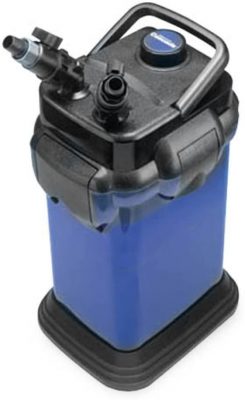
Editor’s Rating:
Why we like it: Adjustable flow rates, a spray bar output, and 360-degree valve flexibility put the Penn-Plax Cascade Canister amongst the best canister filters that money can buy.
Quick Facts:
- Models available: Cascade 500, Cascade 700, Cascade 1000, Cascade 1200, Cascade 1500
- Filter type: Canister
- Filter mechanism: Mechanical, biological, and chemical
- Suitable for tank sizes: 30-200 gallons (dependent on model)
- Flow rate (GPH): 115-350 (dependent on model)
Size
This Cascade range offers high-quality canister filters for tanks from 30-200 gallons, making it the closest rival to the Fluval 07 Series in terms of available sizes. The aesthetic finish isn’t as sleek as with the 07 Series, but this certainly shouldn’t be a deal-breaker, as it’s likely to be stored out of sight anyway.
Filtration
It comes with an adjustable flow output rate, allowing you to gradually increase filtration as your turtle grows, or when you add another to the tank. Plus, the large open-style media baskets mean you can customize the filter media as you wish, and need not feel constrained by awkwardly partitioned, or tightly spaced filter slots.
Maintenance
We love the use of an ‘easy press’ priming button to draw water into the input valve. By comparison, the 07 Series requires a few intense pumps of manual priming to get things started after cleaning. This simple button-press style is much easier than pumping a lever, especially if you plan to store the canister within a tight-fitting cabinet.
The media baskets use a central handle for easy removal, but they’re not quite as robust as on the 07 Series. Plus, the plastic has a glossy finish that makes it more slippery when wet.
Durability
We love that the input and output valves can rotate 360 degrees. So even if you’re pushed for space or plan to run the tubing behind fixed cabinets or desks, you don’t need to worry about awkward angling causing tubing kinks and becoming prone to splitting over time.
Noise
In our experience, this filter emits a constant low-pitch hum – far from ideal for those with a tank setup located in a living space. It’s still quieter than internal and hang-on styles like the Aqua Clear and the Penn-Plax Submersible, but it’s the loudest canister style filter we’ve reviewed.
Pros
- Several size options to choose from
- 360-degree rotating valves
- Adjustable flow output rate
- ‘Easy-press’ priming button
Cons
- Constant humming sound
- Glossy finish makes handles slippery
5. Best Pond Filter: Pond Boss Filter Kit
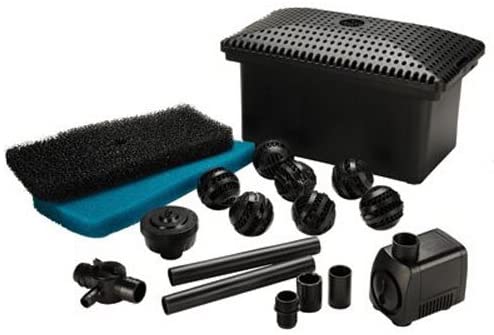
Editor’s Rating:
Why we like it: The Pond Boss Filter Kit is the perfect pick for those who wish to treat their slowpoke friend to some time outdoors in the warmer months.
Quick Facts:
- Filter type: Fountain
- Filter mechanism: Mechanical, biological
- Suitable for tank sizes: Up to 500 gallons (but see below)
- Flow rate (GPH): 320
Size
This filter is for use in outdoor ponds, rather than tanks. But as so many owners like to let their turtle spend the summer days playing in a garden pond, we just had to include it in our list. Just don’t rely on the 320 GPH output, as we find this flow rate a little overstated. Still, unless your pond’s >300 gallons, this won’t have any noticeable impact.
Filtration
As it’s a pond filter, this product should be viewed as an additional device rather than a primary filter, but for pond use the filtration is incredible. It uses a combination of filter media and bio-balls, and we find it does a great job of keeping water crystal-clear. Plus, the water spray nozzle head creates a fountain effect that doubles as a water feature for your garden.
Maintenance
Installation and cleaning are remarkably simple, especially for the size – expect to only have to attend to it every other week or so. Plus, using this as a complementary filter for an outdoor space can help reduce the maintenance time requirement of your primary tank by putting less strain on your existing filter system.
It’s also energy-efficient and should cost less than $2 per month to run continuously.
Durability
Unfortunately, the pump and filter are not particularly stable and you may need to weigh them down to stop them from toppling over. We find a 2-3lb rock should suffice for this purpose, and a rock bed in your pond will look great anyway. Still, for a filter north of $50 we would like to have seen some additional weighting for improved stability.
Noise
The fountain nozzle spray is quite powerful and there’s no escaping the loud splashing sounds as the water breaks the surface. Still, as it’s kept outdoors, this noise is much less noticeable than it would be indoors. The sounds of nature may well do enough to make this a non-issue.
Pros
- Perfect way to create an extra play space for your turtle
- Beautiful fountain effect
- Low maintenance (also reduces maintenance for your primary filter)
- Energy-efficient operation
Cons
- Pump and filter unstable
- GPH flow rate is overstated
6. Best Algae-Clearing Internal Filter: Coospider Sun JUP-01
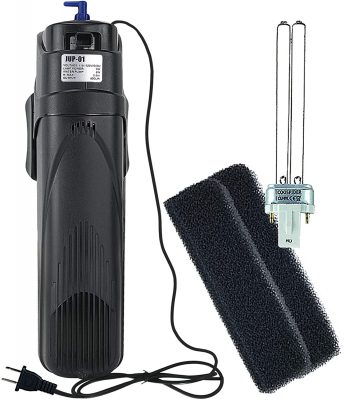
Editor’s Rating:
Why we like it: This internal filter does an excellent job of clearing algae and restoring clear water in problem cases.
Quick Facts:
- Filter type: Internal
- Filter mechanism: Mechanical, biological + UV sterilizer
- Suitable for tank sizes: Up to 80 gallons
- Flow rate (GPH): 210
Size
This filter comes in a single size that’s listed as suitable for up to 80-gallon tanks, but that’s not specific for turtle-keeping. To see the full algae-clearing effect, we suggest you use it in a 40-gallon tank max. If your primary issue is algae, but your tank is >40 gallons, we suggest you opt for the Sunsun HW 304B instead.
Filtration
Like the Sunsun, this filter specializes in fixing algae bloom and green water problems by using UV light to prevent the multiplication/spread of bacterial organisms. It does an incredible job of this and you may well be surprised with just how quickly it fixes your water. In some cases, you can go from green to clear in under 24 hours.
Still, the water inflow is located at the top of this filter, so it’ll need to be almost entirely submerged under the waterline. As aquatic turtles do better with low-level water, we suggest this a ‘treatment filter’ for problem cases when you’re starting to feel like nothing works, rather than as your daily, primary use filter.
PRO-TIP: While you do need round-the-clock filtration, don’t assume you need to run the UV sterilizer 24/7, too. Instead, we suggest that you open the UV sterilizer for between 30-60 minutes per day. This helps clear the water while also maintaining a sufficient level of beneficial bacteria to support turtle health.
Maintenance
The inclusion of UV bulbs adds an extra layer of maintenance to your regular routine as you’ll need to manually switch-on the UV sterilizer each day. Still, it’s generally simple to maintain, partially because it’s much smaller than the larger canister-style devices we’ve reviewed.
Durability
The supplied instructions are a little confusing – so just remember to remove the shock-proof sponge from inside the filter before you place it in the tank, or you’ll risk causing damage. Otherwise, we consider this to be a high-quality build and it comes with a back-up UV bulb, which is a nice touch.
Noise
This filter also includes a built-in air bubbler which adds a nice visual to your tank. There’s even a dial to manually alter bubble production, so you can switch them off entirely if the noise is too much.
Just don’t be alarmed if you hear a loud internal motor sound when it’s first switched on – until water is circulated through the internal system the motors will churn, but this should disappear within a few minutes.
Pros
- Excellent for solving persistent algae-bloom
- Can turn sludgy green water perfectly clear
- Durable build with backup UV light
- Built-in air bubbler
Cons
- No size choices - only suitable for <40-gallon tanks
- Must be submerged under the waterline
- Confusing instructional guide
7. Best Hang-On Filter: Aqua Clear
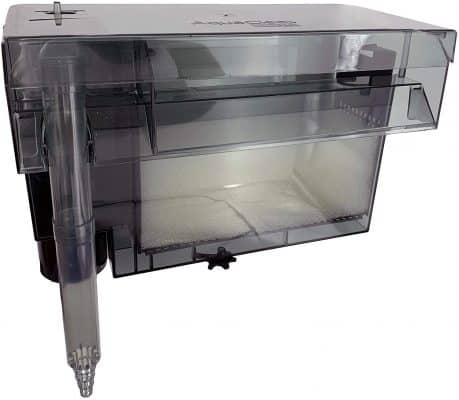
Editor’s Rating:
Why we like it: We love the variable flow this filter offers, and the hang-on design means it won’t take up any space inside or outside your tank.
Quick Facts:
- Filter type: Hang-on
- Filter mechanism: Mechanical, biological, and chemical
- Suitable for tank sizes: Up to 110 gallons (depending on model)
- Flow rate (GPH): 500 (depending on model)
Size
As this filter hangs from the top of the tank, it won’t take up any tank space (like internal filters) or require external storage area space (like canister filters). As such, it’s our favored choice for space-saving.
It’s sold in different sizes, but only the 20-50 gallon and 60-110 gallon sizes are suitable for turtle tanks, in our experience. This is because the advertised GPH flow rate is inaccurate, and the smaller sizes simply won’t turn over enough water to keep a messy turtle tank clean.
Filtration
For a hang-on filter, the overall filtration quality is impressive – but it pales in comparison to the canister filters we’ve reviewed, and there are better options if high-grade filtration is your primary concern.
Still, this is the best hang-on style filter on the market, and if you find this filter style preferable for your set up, your money will be well-spent here. Plus, it includes an adjustable flow rate dial so that you can find the perfect balance for handling the bioload and waste production of your specific tank.
Maintenance
As the media space is much smaller than on large canisters like the Fluval FX6, it will require a more frequent cleaning schedule, but the smaller size also makes this cleaning easy to do. As such, we consider this to be an excellent option for beginner aquarists, especially those with small, hatchling turtles who don’t yet require intensive filtration.
Durability
The Aqua Clear is a well-made filter, but there are infrequent reports of it suddenly not working. If you find this is the case – check the impeller. That’s usually where the issue lies, and it can almost always be restarted with a little manual assistance. In any case, if you follow the manufacturer’s instructions closely when it comes to cleaning, you’re unlikely to have issues.
Noise
The biggest drawback of this filter is the noise. As a hang-on filter, it sits right at the top of your tank. As most turtles are most comfortable with low water depth, the filter output has a long way to fall, which means lots of splashing sounds.
Pros
- Hang-on style doesn’t take up much space
- Variable flow rate dial
- Easy to maintain
Cons
- Advertised GPH is inaccurate
- Occasional impeller failures
- Very noisy
8. Best Budget Filter for Turtle Tanks: Tetra Internal Power Filter With Whisper Filtration
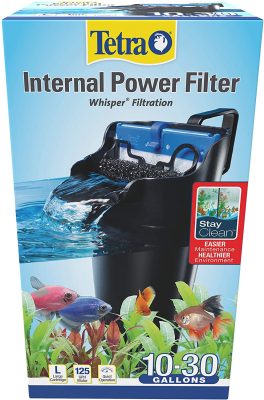
Editor’s Rating:
Why we like it: If you’re buying on a budget, this is the obvious choice. Shockingly cheap and with the bonus of chemical filtration.
Quick Facts:
- Filter type: Internal
- Filter mechanism: Mechanical, biological, chemical
- Suitable for tank sizes: Up to 40 gallons
- Flow rate (GPH): not specified
Size
There’s no GPH listed, and only the 30/40 gallon sizes are suitable for turtle keeping – even then you should follow our 2x recommendation (i.e., 20-gallon max). Ultimately, this filter only suits tanks on the smaller end of the scale, but for the size it’s incredible value for money and the cheapest way to add effective filtration to your turtle tank.
Filtration
On first look, this would appear to be a standard internal-style filter, but the motor’s impeller is located at the bottom of the filter structure, so it’ll function in only 2 inches of water. This allows you to keep a shallow water level to suit your turtle – similar to the ReptoFilter.
It also comes with added chemical filtration (via charcoal filter pads), which is a bonus, especially for the low price.
Maintenance
This filter uses bio-bags (again like the ReptoFilter) which are excellent for odor control and help you make simple switch-outs of filter media, when required. It’s easy to change out the filter’s chemical pads too, but we expect you’ll find deeper-cleaning a little awkward. The pump doesn’t come completely apart so you’ll need to exercise some patience when getting into the nooks and crannies.
Durability
Poor durability is the biggest disadvantage of this filter. The suction cups are weak, and we find it’s a little too prone to failure. Don’t be shocked if you need a replacement within the year. Considering it’s likely to set you back less than $20, this should perhaps be expected, though.
We see this as being well suited to beginners with small turtles who want a cheap start and would feel more comfortable with a bigger spend after they’ve grown into the hobby.
Noise
While it’s advertised as a ‘whisper’ filter, this doesn’t apply when it’s used for turtle-keeping. With a low waterline, the filter will create a waterfall-style effect which gets noisy when it breaks the surface. For the price, it’s hard to complain – just don’t be fooled by the ‘whisper filtration’ name.
Pros
- Very affordable
- Includes chemical filtration
- Impeller location allows for a low waterline
Cons
- Loud
- Prone to failure
- Weak suction cups
9. Best No-Noise Filter: Penn-Plaxx Cascade 600 Submersible

Editor’s Rating:
Why we like it: Penn-Plax’s Submersible filter has multi-directional water flow and a handy spray bar output, as well as super-quiet operation.
Quick Facts:
- Filter type: Internal
- Filter mechanism: Mechanical, biological, chemical
- Suitable for tank sizes: Up to 50 gallons
- Flow rate (GPH): 175
Size
The Penn-Plaxx Cascade comes in a single size, and we find the advertised GPH is a realistic indication of performance. That said, it’s not specifically designed for turtles, so only consider this filter if you have a tank that holds 25 gallons or under.
Filtration
This is an internal filter with a twist, quite literally. Unlike the Coospider Sun and the Tetra Internal, it doesn’t require vertical positioning.
In fact, you can set the filter horizontally and the spray bar will evenly distribute the water output across the entire length of your tank. As well as looking cool, you’ll be able to keep the waterline in your tank low, giving your turtle(s) plenty of basking space.
It also comes with ‘Venturi Aeration’ which is essentially a built-in air bubbler. This and the Coospider are the only filters to offer this feature, and it’ll save you some money if you were considering adding a bubbler to your setup for increased water oxygenation.
Maintenance
The filter media pads can be switched out in seconds. This part is simple. The real problem here is how difficult it is to slide open the main compartment to access them. To do so you need to press the tabs at each side, simultaneously and very firmly. It’ll take you some time to get the technique down, and even then it’s far from easy.
Durability
While difficult to open, the solid construction helps this filter remain sealed in all the right places, and it’ll stay in good condition despite its need for constant submersion. The overall durability is let down somewhat by the suction cups, though.
As with the Tetra Internal, these suction cups loosen over time and will need re-sticking to the glass now and then. As a workaround, we find that positioning the filter horizontally across the bottom of the tank adds more pressure to the suction cups and makes them less likely to come unstuck.
Noise
This is the quietest internal filter we reviewed, and as long as it’s just under the waterline you’ll barely notice it’s running. If you have a child who keeps a turtle in their bedroom, this might just be the best choice on the list.
Pros
- Multi-directional water flow
- Spray bar output
- Includes ‘Venturi Aeration’
- Super quiet operation
Cons
- Casing is very difficult to open
- Weak suction cups
10. Best UV Sterilizing Canister Filter: SunSun HW 304B
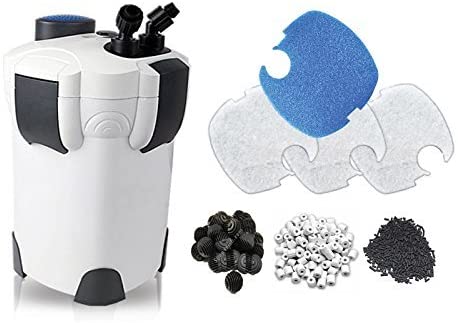
Editor’s Rating:
Why we like it: If you’re struggling with microalgae bloom but need some serious filtration power the Sunsun HW 304B is a cheaper alternative to other canister options we’ve seen.
Quick Facts:
- Filter type: Canister
- Filter mechanism: Mechanical, biological, chemical + UV light sterilization
- Suitable for tank sizes: Up to 150 gallons
- Flow rate (GPH): 525
Size
This is a sizable canister filter with a terrific flow rate, suitable for large tanks and those that house multiple turtles. As a canister, it does require some external tank space to function, but at 17” tall it’s still considerably smaller than the Fluval FX6.
Filtration
On top of the 3-stage filtration, this filter’s standout feature is its 9-Watt UV light sterilizer. This works identically to the Coospider Sun just on a larger scale. It also comes with a simple push-button style self-priming pump, eliminating any need for manual siphoning.
Maintenance
Unfortunately, the assembly instructions aren’t beginner-friendly (written in poor English and with little explanation), so this is a better choice for experienced hobbyists who are already familiar with canister filters. The filter media baskets can be a little loose-fitting too, so the mechanical filtration isn’t as effective as on the Fluval 07 Series or the Fluval FX6.
Durability
Sunsun filters are of comparable quality with the bigger brand names like Fluval and Penn-Plax, but there’s an increased risk of issues after the first few years of use (like impeller problems and loose intake tubes). These are usually fixable, but require a little patience and some understanding of the internal mechanisms, another reason we don’t suggest this for beginners.
Noise
Sunsun occupies a middle-ground here, which isn’t a bad thing. It’s not as quiet as the more premium canister-style filters as the canister itself tends to vibrate, but it’s less noticeable than every internal style and hang-on filter that we’ve seen.
Pros
- Impressive GPH
- UV-Sterilizer
- Self-priming pump
Cons
- Doesn’t have the longevity of other canister filters
- Filter media baskets are ill-fitting
- Not beginner-friendly
Guide to Buying the Best Filters for Turtle Tanks
Our product reviews should have gone a long way towards showing you why a turtle tank filter is a worthwhile investment. But just in case you need any more convincing, let’s start our guide with a quick benefits summary.
The Dirty Truth: Why You Need a Turtle Tank Filter
Turtles create more waste than fish, their habitats smell more, and they’re also carriers of dangerous diseases like salmonella. If your tank’s filtration is insufficient, dangerous levels of ammonia, fluoride, and chlorine will build up in your tank and can cause your turtle (and even you) long-term damage.
If that’s not enough to worry about, filthy glass and dirty water are total eyesores and completely ruin the ambiance of your tank. Thankfully, an effective filtration system handles all of these problems, by doing the following.
- Removing visible waste (like poop, uneaten food, and floating algae)
- Removing invisible and harmful substances (like ammonia)
- Circulating stagnant water to prevent ‘dead spots’
- Capturing and containing foul odors
While a good filter might feel like magic, there’s actually a complex process taking place within the plastic exterior of these filters. Let’s take a look.
Methods of Filtration
For beginners, learning about the different filtration types can be overwhelming, but it’s important to understand the basics so you can keep your aquatic friend in tip-top shape. Once you know your stuff, you can safely choose a filter that’s capable of processing all the typical nasties found in turtle tank water.
Each method works in a different way to help maintain safe water chemistry – here are our no-nonsense explanations.
1. Mechanical Filtration
This is what you imagine when you think of the word ‘filter.’ It uses filtration media (like sponge, filter floss, or DIY filter media) to physically strain out the ‘bad stuff’ that you see when you look into a tank. Poop, decaying food, dust, algae – that sort of thing.
2. Biological Filtration
When your turtle takes a pee, ammonia is released into the water. Mechanical filtration doesn’t process this, but biological filtration can. This method uses porous, sponge filter media to encourage bacterial growth – the good kind.
This colony of ‘good bacteria’ can break down the ammonia into nitrite. A second colony of ‘good guys’ in the filter, then convert this nitrite into nitrate. While nitrate itself can be harmful in higher doses, it will be removed during your routine water changes and is much less of an issue than ammonia.
3. Chemical Filtration
Chemical filtration uses different types of filter media (most commonly activated carbon) to ‘patch the leaks’ and capture the things that mechanical and biological filtration miss.
While it can really help keep the tank water extra clear and any foul odors to a minimum, it’s the least essential filtration type, and it can interfere with any medications you may add to the tank. You should see this as a useful bonus, but not a necessity.
Filter Types: Canister vs. Internal vs. Hang-On
So that’s how filtration works. But how does it actually get done? That comes down to the filter type used. Let’s start with the two most common types – canister and internal.
Canister Filters
These canisters sit outside the tank and use separate input/output hoses to filter water to/from the tank. Compared to internal filters they use stronger motors, are filtered through more media, and have a much higher GPH.
Overall, when space and cost aren’t your primary concerns, a canister filter will usually be the best pick you can make.
Pros of Canister Filters:
- Most effective filtration (high GPH flow rate)
- Can hold a significant amount of filter media
- Don’t take up tank space or impact the aesthetic (stored externally)
- Easier to maintain
Cons of Canister Filters:
- More expensive
- Take up more space external to the tank
Internal Filters
Best used for smaller tanks, these filters sit inside the tank itself and are attached to the glass with suction cups, or are built into decorative structures.
Pros of Internal Filters:
- Don’t require external housing
- Can be disguised by rocks and plants
- Usually cheaper than canister filters
- Less capacity for filter media (needs replacing more often)
- Maintenance can get messy
- Lower GPH
- Take up internal tank space
- Sometimes require a high waterline to function (more on that below)
Other Filter Types
Hang-On Filters
As the name might suggest, these filters latch onto the top of tanks, creating a waterfall effect as the filtered water cascades downwards.
They usually require the tank’s water level to be as high as the filter itself, meaning the tank must be almost completely filled with water. This can be a problem for turtle tanks – many species require a lower waterline to also accommodate a dry basking space area.
Undergravel Filters
Take our advice and steer clear of these. Undergravel filters are unsuitable for turtle tank filtration because they work by sucking particulate water through a gravel substrate at the bottom of the tank. Unfortunately, turtles dig too much for this system to work. You’ll end up with a clogged filter system and the harmful waste being kicked back up to the surface.
How to Pick the Perfect Filter for Your Tank
Still struggling to know which turtle tank filter is right for you?
Our factors to consider explored the general attributes of high-quality filters, but it’s not always enough to know the best products – you really need to know the best products for you. Even if a filter has A1 performance, if it doesn’t fit with your setup, it’s a waste of time and money. Here’s how to pick.
1. According to Size
Underestimating your filtration requirements is a sure-fire way to end up with murky swamp water and an unhealthy turtle. This is the biggest mishap when buying filters for turtle tanks, so pay close attention to our recommendations below.
If a filter is advertised for use with turtles, buy per the advertised size suitability. If not, buy a filter that’s suitable for twice the capacity of the tank you own. For example, a filter that’s ‘suitable for tanks up to 100 gallons’ should only be used in up to a 50-gallon turtle tank, unless it’s specifically indicated for turtles.
To make things even easier, here are our specific product recommendations for common tank sizes.
20-Gallon Tanks
We recommend: ReptoFilter or Tetra Internal Power Filter
20-gallon tanks don’t need an elaborate setup or a crazy flow rate, and a good internal filter will be sufficient in most cases. Smaller tank sizes are also most common amongst beginners and if you consider yourself to be one, we’d further encourage using an internal filter – they tend to be a little easier to get to grips with.
Just make sure to keep a regular maintenance schedule because smaller tanks are more susceptible to water chemistry problems. We should also mention that even for hatchlings you should avoid using a tank below 20 gallons. Most turtles will outgrow these small nanotanks within months and you’ll be left needing a bigger tank as well as a bigger filter.
20-50 Gallon Tanks
We recommend: Fluval 07 Series or ReptoFilter
Tanks in this range can usually still accommodate internal and hang-on filters, but small/mid-size canister filters tend to be more efficient. If you’re not constrained by budget, we’d suggest the latter. If you’d prefer to spend a little less, just make sure the filter you choose is specifically designed for use with turtles and can handle their waste production.
50-100 Gallon Tanks
We recommend: Penn-Plax Cascade Canister or Sunsun HW 304B
For tanks over 50-gallons, you should opt for a sizable canister filter that has 3-stage filtration, with large filter media compartments that can go a few weeks between cleaning.
100+ Gallon Tanks
We recommend: Fluval FX6.
For tanks this big, you want as much filtration power as you can get and a top-end canister filter is the only thing that will do the trick.
2. According to Species
Every species varies in its size, the amount of waste produced, and the basking space needed. All of these factors impact filter suitability. Here’s our advice for the most common pet turtle species.
Musk/Mud Turtles
In our experience, common musk turtles and mud turtles species do well with internal filters as they rarely grow longer than 5 inches and aren’t the strongest swimmers. In fact, strong water currents may be problematic for them, so high-powered canister filters are not the best choice.
Instead, internal filters like the ReptoFilter or the Penn-Plax Submersible will work well.
Red-Eared Sliders
If you own a red-eared slider, you should always opt for a canister filter, such as the Fluval 07 Series. Even if your little guy is small right now, these turtles can grow to a whopping 12 inches and most internal filters just aren’t capable of the kind of filtration these boys need.
PRO-TIP: Don’t forget to factor in other tank inhabitants into your filtration requirements. If you own a species that lives harmoniously with community fish, these little critters will further contribute to your tank’s bioload, even if they seem tiny in comparison. The same goes for multiple turtles – two turtles require twice the filtration!
Guide to Turtle Tank Cleaning & Maintenance
Now that you’ve picked your filter, it’s time to get those hands dirty! While a high-quality filter sets the right foundation, your hard-earned cash will go to waste if you don’t keep a consistent cleaning and maintenance routine.
The ideal cleaning frequency will depend on the filter you buy and the amount of work it’s challenged with, but cleaning the filter media every other week is a good guideline to start. Skip a cleaning session and you’ll soon be reminded that you did, thanks to one or more of the following warning signs.
- Reduced output (GPH drops off)
- Unbalanced water parameters
- Green, slimy water with visible dirt and debris
PRO-TIP: Struggling to maintain a regular cleaning schedule? If your turtle’s running rings around you, you may benefit from a helping hand. Consider adding live plants to absorb ammonia or ‘cleaning crew’ fish that can tackle excess food and consume algae. Just make sure to check cohabiting suitability with your species of turtle to avoid any nasty surprises!
Here’s our step-by-step guide for how to clean your filter media and keep that tank water sparkling.
Step-by-Step Filter Media Cleaning Process
- Unplug the filter before you disassemble it to avoid any electrical hazards
- Wear gloves to avoid risking transmission of salmonella and other harmful pathogens
- Fill a bucket with room temperature water
- Disassemble the filter and remove the filter media from the compartment
- Hold the filter sponge(s) in your palm and submerge in the water bucket
- Lightly squeeze the sponge(s) several times to expel the dirt and draw in clean water
- Repeat until the water runs clear when the sponge is squeezed above the bucket
- Return the filter media to the filtration compartment
- Wipe down any drips or spillages, especially close to wiring
- Switch the filter back on
- Thoroughly wash your hands and immediately wash any wet clothing with detergent
Frequently Asked Questions
Do I Need Multiple Filters for My Turtle Tank?
As long as your filter has a sufficient GPH flow rate for your tank size, you don’t need multiple filters. However, multiple filters can increase ease of maintenance by reducing the necessary cleaning frequency and allowing one filter to keep running while the other is cleaned. Cleaning filter media in turn like this can help prevent a bacterial ‘die-off’ reaction in the filter media, which can harm aquatic life.
When Should I Replace the Filter Media in My Turtle Tank?
Once you notice that your regular cleaning process doesn’t restore your tank to its former glory and you start to long for the days of crystal clear water, it’s probably time to replace the filter media.
Remember, it’s taken time for this media to build up a colony of good bacteria that keeps your water chemistry stable. Sudden changes could result in ammonia spikes, so we advise that you leave a few days between swapping out each sponge.
Why Is My Turtle Tank Always Cloudy?
Cloudy tank water is usually caused by one of two things.
- Your filter’s flow rate is insufficient for your tank (i.e., size and bioload)
- Your regular cleaning routine is insufficient
Check that your filter has the capability to serve the size of your tank, and the turtle(s) and other aquatic life kept within it. If you’re still having issues, replace your filter media and commit to more frequent water changes.
If your tank water still looks like pea soup, you may have fallen victim to a microalgae bloom. A regular water filter won’t save you here. You’ll need the help of a UV light sterilizer to stop the bacteria from multiplying and allow the water to clarify. The Coospider Sun and the Sunsun HW 304B are the best filters we’ve seen for this purpose.
Filtering the Good From the Bad
There’s no doubt about it, turtle-keeping can be a tricky business, and as many pet species live up to 40 years, you’re in it for the long haul.
With the amount of waste turtle’s produce, even a slightly under-powered filter will quickly become apparent and soon start to negatively impact your pet’s health. Who knows – leaving your turtle to swim in a tank full of swampy sludge for too long might even turn them into a mutant-ninja? We wouldn’t risk it!
Ultimately your turtle(s) deserve a clean, healthy environment where they’re living (and looking) at their best. Luckily, you’re now armed with everything you need to keep your tank water, and conscience, crystal-clear at all times.

